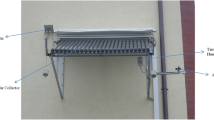Abstract
Cyprus is currently the leading country in the world with respect to the application of solar water heaters for domestic applications, with more than 93 % of the houses equipped with such a system. The great majority of these solar water heaters are of the thermosiphonic type. Currently, the knowledge about the parameters affecting the ‘thermosiphonic phenomenon’ is rather poor while on an international level (International Organization for Standardization, ISO, and Comité Européen de Normalisation CEN committees) there is no standard available to test thermosiphon solar collectors. The deeper understanding of the ‘thermosiphonic phenomenon’ and the identification of the key parameters affecting it is the main aim of a research project currently in process in Cyprus.
In this chapter, the experimental results of the research project are presented. Specifically, a special test rig was set up and equipped with all the sensors necessary to measure all the parameters that are most likely to affect the ‘thermosiphonic phenomenon’. All tests were conducted according to ISO 9459-2:1995(E). The system was able to operate in various weather and operating conditions and could accommodate the change of inclination of the collector. During the experimental procedure, three different inclination angles of the solar collector were tested in order to evaluate their effect on the generation of thermosiphonic flow. The thermal performance of the collector was calculated both in thermosiphonic operation and also according to EN12975-2:2006 in order to determine the thermal performance at a flow and operation conditions specified by the standard. Finally, a series of correlations were attempted using the experimental results for the thermosiphonic operation of the collector which are the following: (i) the temperature difference of the water at the outlet and the inlet of the collector (ΔT) with solar global radiation, (ii) the water mass flow with the solar global radiation and (iii) the water mass flow with the temperature difference of the water at the outlet and the inlet of the collector. The results of the data analysis showed that the examined parameters were well correlated and also the optimum inclination angle in terms of the highest thermosiphonic flow generation was that of 45°.
Access this chapter
Tax calculation will be finalised at checkout
Purchases are for personal use only
Similar content being viewed by others
References
Kalogirou S (2009) Thermal performance, economic and environmental life cycle analysis of thermosiphon solar water heaters. Sol Energy 83(1):39–48
Close DJ (1962) The performance of solar water heaters with natural circulation. Sol Energy 6:33
Hahne E (1983) Parameter effects on design and performance of flat plate solar collectors. Sol Energy 34:497–504
Morrison GL, Braun JE (1985) System modelling and operation characteristics of thermosiphon solar water heaters. Sol Energy 34:389–405
Hobson PA, Norton BA (1989) A design monogram for direct thermosiphon solar energy water heaters. Sol Energy 43:89–95
Kalogirou SA, Papamarcou C (2000) Modelling of a thermosiphon solar water heating system and simple model validation. Renew Energy 21:471–493
Chuawittayawuth K, Kumar S (2002) Experimental investigation of temperature and flow distribution in a thermosiphon solar water heating system. Renew Energy 26:431–448
Jiang DY, Wei H, Hou JX, Jei J (2010) A new performance evaluation method for solar thermosiphon systems. Int J Carbon Technol 5:239–244
Riahi A, Taherian H (2011) Experimental investigation on the performance of thermosiphon solar water heater in the south Caspean sea. Therm Sci 15:447–456
Bannerot RB, Tu YW, Scott A, Placke G, Poché T (1992) A simple device for monitoring flow rates in thermosyphon solar water heaters. J Solar Energy Eng 114(1): 47–52
Acknowledgments
This work was carried out as part of a research project co-funded by the Research Promotion Foundation (RPF) of Cyprus under contract ΤΕΧΝΟΛΟΓΙΑ/ΕΝΕΡΓ/0311(ΒΙΕ)09 and the European Regional Development Fund (ERDF) of the EU.
Author information
Authors and Affiliations
Corresponding author
Editor information
Editors and Affiliations
Rights and permissions
Copyright information
© 2016 Springer International Publishing Switzerland
About this chapter
Cite this chapter
Panayiotou, G. et al. (2016). Experimental Investigation of the Effect of Solar Collector’s Inclination Angle on the Generation of Thermosiphonic Flow. In: Sayigh, A. (eds) Renewable Energy in the Service of Mankind Vol II. Springer, Cham. https://doi.org/10.1007/978-3-319-18215-5_73
Download citation
DOI: https://doi.org/10.1007/978-3-319-18215-5_73
Published:
Publisher Name: Springer, Cham
Print ISBN: 978-3-319-18214-8
Online ISBN: 978-3-319-18215-5
eBook Packages: EnergyEnergy (R0)




